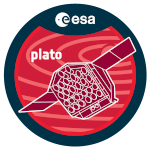There is a small number of known delta Scuti stars with transiting exoplanets. The analysis of such systems is challenging because the pulsation distorts the transits and therefore, the proper subtraction of the pulsation pattern is essential in order to model the transit light curves correctly. In addition, in close systems, the tidal forces of the companion may influence the oscillations. We performed photometric analysis of two such systems, WASP-33 and HD 31221, using Transiting Exoplanet Survey Satellite (TESS) space telescope data. We modeled the transit light curves with the Transit and Light Curve Modeller (TLCM) code and determined the basic parameters of the systems. We also found evidence of tidally perturbed stellar oscillations related to the substellar companions. The continuous and longer time span of PLATO observations will allow better modeling and understanding of these kind of systems in terms of the transits and the pulsation.
|
|
|
|
Delta Scuti stars with substellar companions
1 : ELTE Gothard Astrophysical Observatory, Szombathely, Szent Imre h. u. 112., H-9700, Hungary
2 : MTA-ELTE Lendület “Momentum” Milky Way Research Group, Hungary
3 : ELKH-SZTE Stellar Astrophysics Research Group, H-6500 Baja, Szegedi út, Kt. 766, Hungary
4 : ELTE Eotvos Lorand University Doctoral School of Physics, Pázmány Péter sétány 1/A, 1117 Budapest, Hungary
5 : Konkoly Observatory, Research Centre for Astronomy and Earth Sciences, Eötvös Loránd Research Network (ELKH), Konkoly-Thege Miklós út 15-17, 1121 Budapest, Hungary
6 : CSFK, MTA Centre of Excellence, Budapest, Konkoly Thege Miklós út 15-17., H-1121, Hungary
7 : MTA-ELTE Exoplanet Research Group, Szent Imre h. u. 112, 9700 Szombathely, Hungary
8 : University of Szeged, Department of Optics and Quantum Electronics, Institute of Physics, Dóm tér 9, 6720 Szeged, Hungary
|

 PDF version
PDF version
